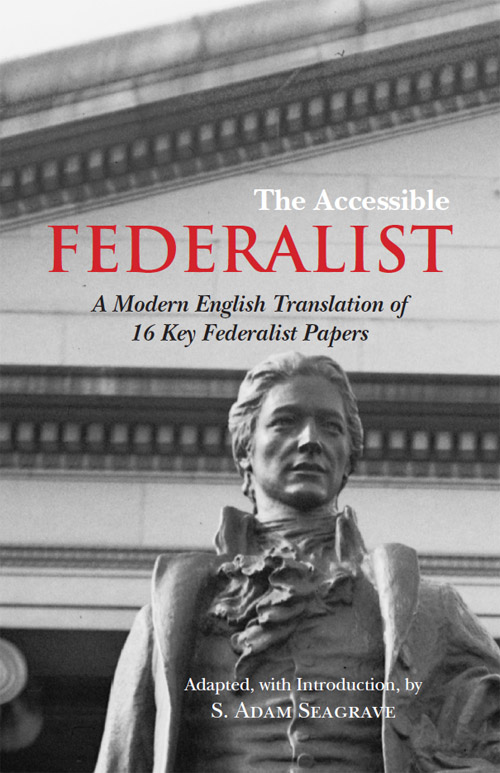Publius
The Accessible
Federalist
Publius
The Accessible
Federalist
A Modern English Translation of
16 Key Federalist Papers
Adapted, with Introduction, by
S. Adam Seagrave
Hackett Publishing Company, Inc.
Indianapolis/Cambridge
Copyright 2017 by Hackett Publishing Company, Inc.
All rights reserved
Printed in the United States of America
20 19 18 17 1 1 2 3 4 5 6 7
For further information, please address
Hackett Publishing Company, Inc.
P.O. Box 44937
Indianapolis, Indiana 46244-0937
www.hackettpublishing.com
Cover design by Brian Rak
Composition by Aptara, Inc.
Library of Congress Cataloging-in-Publication Data
Names: Seagrave, S. Adam, adapter.
Title: The accessible Federalist: a modern English translation of 16 key Federalist papers adapted, with introduction / by S. Adam Seagrave.
Description: Indianapolis ; Cambridge: Hackett Publishing Company, Inc., [2017] | Includes index.
Identifiers: LCCN 2016035418 | ISBN 9781624665509 (pbk.) | ISBN 9781624665516 (cloth)
Subjects: LCSH: Constitutional historyUnited StatesSources.
Classification: LCC KF4515 .F4 2017 | DDC 342.7302/9dc23
LC record available at https://lccn.loc.gov/2016035418
ePub ISBN: 978-1-62466-607-0
Contents
The page numbers in curly braces {} correspond to the print edition of this title.
Scott J. Hammond, Kevin R. Hardwick, and Howard L. Lubert, eds., Classics of American Political and Constitutional Thought, Volume I .
Scott J. Hammond, Kevin R. Hardwick, and Howard L. Lubert, eds., Classics of American Political and Constitutional Thought, Volume II .
Frederick Douglass, The Essential Douglass . Edited, with an Introduction, by Nicholas Buccola.
Alexis de Tocqueville, Democracy in America. Abridged, with Introduction, by Sanford Kessler. Translated and Annotated by Stephen D. Grant .
{vii}
I would first like to thank Gary Glenn, a legendary teacher of American political thought at Northern Illinois University for the past half century. It was during the course of one of our usual morning conversations in the office at NIU that I became excited about the idea for this work, and it was while teaching a course he invented that I honed my ability to successfully undertake it. I benefited enormously from Garys mentorship as a junior faculty member and will continue to draw on his example throughout my teaching career.
Many thanks are also due to Jim Read and an anonymous reviewer for their careful reading of the manuscript and for offering excellent suggestions for its improvement at various points throughout. Brian Rak provided outstanding editorial direction of the project from beginning to end. I take full responsibility for any errors that remain.
{ix} I.
Introduction
There was a time when the Constitution was not yet a historical document. There was a time before it had been subjected to the interpretation and reinterpretation of the Supreme Court over the course of hundreds of cases. There was a time when it looked doubtful that the people of the thirteen independent states would agree to a plan for a new federal government that had been produced in secrecy and without legal authorization.
It was at this time that Alexander Hamilton, James Madison, and John Jay wrote the newspaper articles that together would become The Federalis t . They united under one name, Publius, and shared one purpose: to persuade the people of New York to support ratification of a new Constitution for the United States. This proposed Constitution was written and adopted by a convention of delegates appointed by individual states, a convention whose official purpose was to revise the existing Articles of Confederation. These delegates shared a justifiably urgent concern for the viability of the fledgling United States, and they quickly realized that their task of rescuing the United States required more than a simple revision of the Articles.
The Articles of Confederation had created a league or treaty between the states rather than a government for the nation like those in existence for each of the states. The states each had one vote in the Congress, and unanimity was required. The individual citizens of the states had no direct connection with the national government; they werent represented within it, and they couldnt be directly acted upon by it. The Union that was created as a military alliance during the Revolutionary War continued to act as a mere alliance after the war was over. The United States under the Articles of Confederation was organized along the same lines as all preceding confederations in history, and it was destined to collapse in precisely the same way: through the inability of the central government to effectively coordinate national affairs.
Because of this, the Articles of Confederation needed to be entirely replaced. As Hamilton put it in Federalist 15, the evils we experience do not proceed from minute or partial imperfections, but from fundamental errors in the structure of the building, which cannot be amended {x} otherwise than by an alteration in the first principles and main pillars of the fabric. And Madison described the Constitutional Convention in Federalist 40 as deeply and unanimously impressed with the crisis, which had led their country almost with one voice to make so singular and solemn an experiment for correcting the errors of a system by which this crisis had been produced. The structure of the federal union had to be entirely remade, and an essential part of this remaking was the formation of a national government with sufficient authority and power to counterbalance that of the individual states.
Despite their unanimous agreement on the necessity of adopting an entirely new Constitution, the convention delegates knew they would face a difficult battle in securing its ratification by the specially-elected state conventions. The people knew essentially nothing about the proposed Constitution until it was actually placed in front of them for their consideration. Something so novel in conception and momentous in importance would require all of the persuasive ability the convention delegates could muster for its support. It was far from certain that the Constitution would be ratified, and the efforts of Federalists such as the Publius authors would be absolutely crucial in bringing this about.
The Federalist differs, then, from most books of political philosophy not only in its multiple authorship but also in its direction to a definite practical purpose. Hamilton, Madison, and Jay each had their own distinct opinions about politics, and these opinions didnt always fit neatly together. And because they were engaged in a debate with very practical and even personal stakes, they had powerful motivation to bend their arguments to better serve their ultimate goals. The arguments presented in The Federal ist are, in other words, delivered to us in far messier fashion than the stereotypical armchair utterances of the disinterested philosopher.
In the very first Federalist essay, Hamilton warns his readers that the arguments on both sides of the ratification debate are likely to be accompanied by a false bias brought about by ambition, avarice, personal animosity, party opposition, and many other motives. He doesnt exempt himself from this sort of bias, even while being careful to heap more doubt upon his opponents motivations than his own. In a sobering and brilliant commentary on the nature of public debate at this critical juncture in Americanand indeed humanhistory, Hamilton deftly attempts to achieve some distance for himself and his coauthors from the obvious charge of bias that would naturally be leveled against them in their attempt to defend the proposed Constitution.

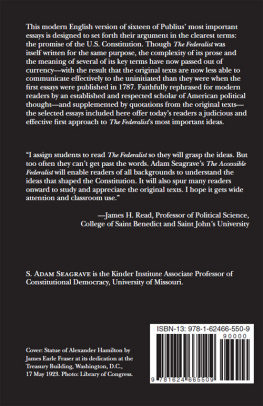

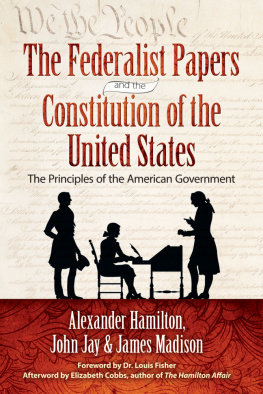
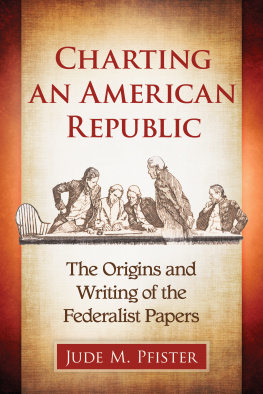
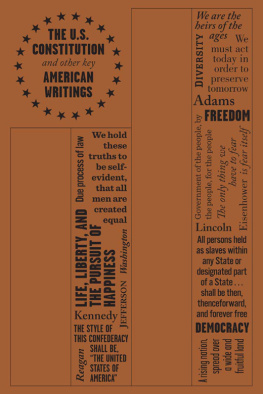
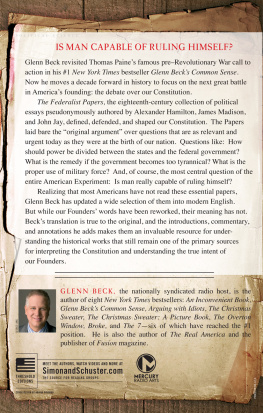
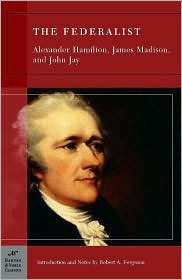
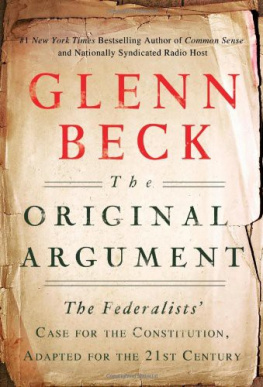
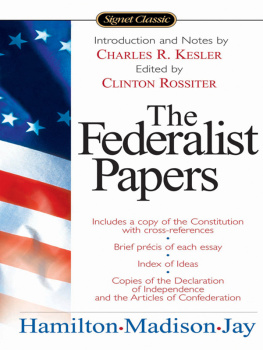
![Jay John - The Federalist : a collection of essays, written in favour of the new Constitution, as agreed upon by the Federal Convention, September 17, 1787. : In two volumes. Vol. I[-II.]](/uploads/posts/book/76130/thumbs/jay-john-the-federalist-a-collection-of-essays.jpg)

